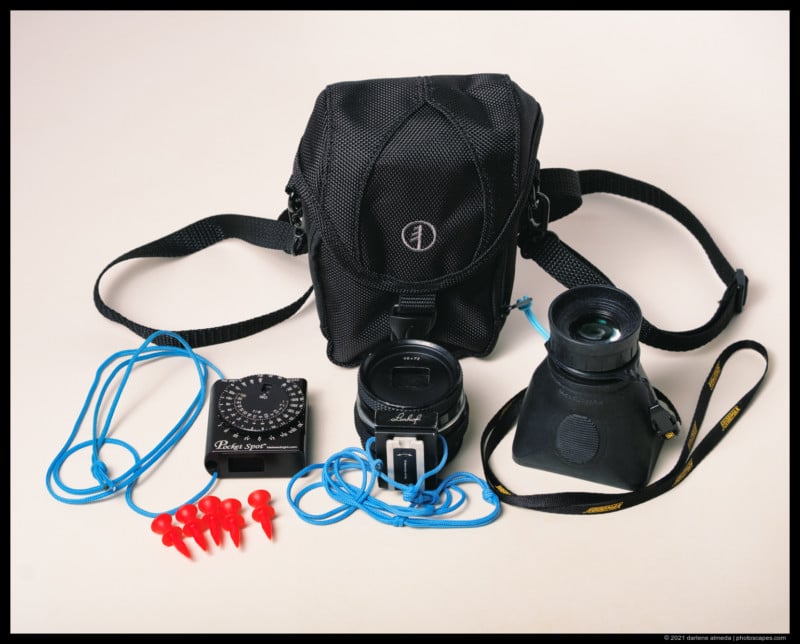
I create my landscape photography with film and digital technical cameras and received a request to share how I compose in the landscape with the gear I use.
Learning how to compose images is not a simple topic to cover, nor can that be shared in one article alone. However, sometimes we can find tidbits of information from other photographers that can add to our technique and save time, expense, or simply makes sense to our particular way of looking at things. My objective in this article is to share the pre-visualization technique that guides me to where I need to set up the camera.
Photographers who shoot tech cameras — be they pancake, field, or view camera design — have a few things in common. One is their pursuit of perfection. Why else do we get hooked on cameras that at first look may be mistaken for a measuring device instead of a camera? Another common thread is the amount of care and time we must put into their operational use. I am always looking for ways to save time while pursuing this perfection. My landscape shooting technique has changed over the years, and the switch to Live View on a digital back over an interchangeable ground glass was a welcome change, but the one constant need I have that never changes: previsualization.
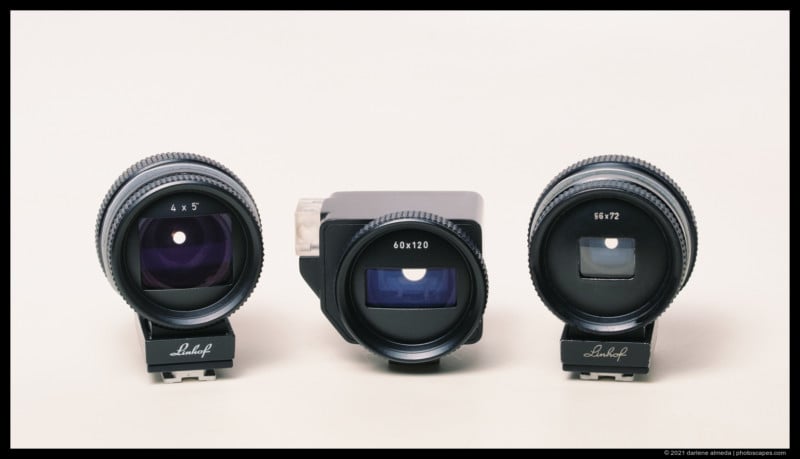
Viewfinders
Walking around looking through a detachable viewfinder is how I find compositions in the landscape; this is previsualization. I could use a black frame cutout made from mat board if I had too, but being able to use a small handheld viewfinder that matches my camera lenses with the film or digital sensor format is my first tool of choice. With the various format sizes available, it may not be easy to find exactly what you need, but over time I have been able to tweak my viewfinders to match my needs. Using a DSLR and a zoom lens may work as well, but that idea does not interest me because I want to be as minimalistic as possible. This Lens Visualizer Tool has helped me previsualize lenses and formats.
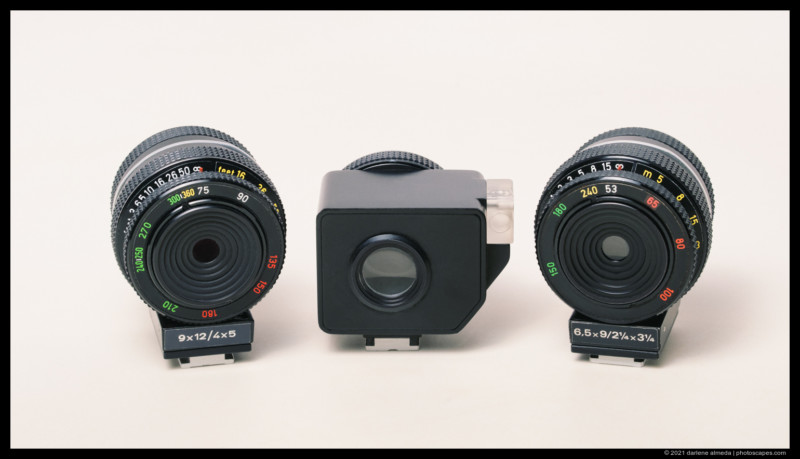
Technique
Most of my landscape shooting is done after I drive around looking for interesting views and then park and walk. I grab my Composing Tools Kit which will have the viewfinder for the tech camera I will be shooting, as well as a small light meter, Hoodman rubber loupe, and location tees. The light meter and Hoodman loupe are handy tools I keep with me on all landscape shoots. The light meter is for when I am shooting film, but if I am pressed for time in a weather or other situation while shooting a digital back, I can quickly get a meter reading without having to spend extra time looking at the histogram. The Hoodman loupe is an excellent cover for the digital back’s screen in bright sunlight, and since it is made of a rubberized material, it does not scratch the digital display. Once I find a location I want to return to with my camera, I place a location tee in the ground. I have not had a problem reclaiming a location tee, and if I did, I might resort to a GPS unit, but that seems a bit much at this time since a lot of the areas I venture into have intermittent cell coverage, and I really want to keep the gear to a minimum.
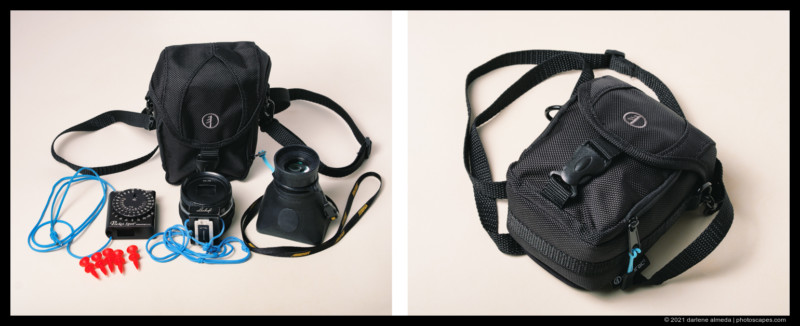
Cameras
The tech cameras I shoot include an ALPA SWA, a Cambo Wide 650, and a Linhof Master Technika 3000. I have shot digital and film with all of these cameras, but today I primarily shoot film with the Cambo Wide and Linhof 3000 and digital with the ALPA. Shooting black and white film is something I do not think I will ever give up, and shooting digital with my ALPA cameras has replaced any idea of shooting color film with a tech camera for me. All of these cameras have their own detachable viewfinders and I hardly, if ever, use the viewfinder on the camera. Now I will talk about how I previsualize with each camera.
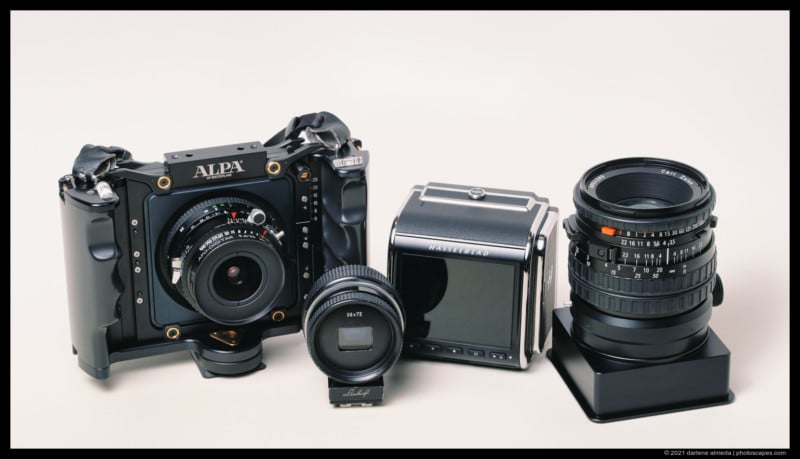
ALPA SWA
I chose the ALPA camera system for medium format digital because of its minimalistic size with the ability to adapt Hasselblad lenses and accessories. I use a CFV II 50C digital back and Hasselblad “C” film magazines with these cameras. My lenses are the ALPA Schneider digital lenses: 28, 35, 47, 72, and 120, and the Hasselblad V lenses: 60, 80, 100, 120, and 180. When I take my ALPA kit out in the landscape, I generally take a wide, normal, and telephoto. A typical pack will have the 35, 100, and 180. If I am shooting on location where I will be inside of structures, then it would be the 28, 72, and 120. Finding the correct aspect ratio for my 44×33 digital back and a viewfinder took a bit of testing, but I found the Linhof 6×9 viewfinder fitted with a 56×72 mask made for the 4×5″ viewfinder matched up nicely to my lenses according to the numbers on the viewfinder dial. When shooting film, I simply replace the mask with a different 56×72 mask designed for the 6×9 format. Once I find an interesting scene, I turn the dial of the viewfinder to match a lens I have packed. I will then scan the landscape looking for compositions. Once I find what I am looking for, I place a location tee down and move on, or move back to my van and set up the camera to return for the photography. I focus via Live View when shooting digital and use a Hasselblad ground glass for film focusing.

Cambo Wide 650
I acquired the Cambo Wide specifically for 6×12 black and white film panoramic shooting. The Cambo Wide is a lighter-weight 4×5″ camera that gives its users many options through the use of its Graflok back. Finding the Linhof Technar 65 viewfinder was a great find as the viewfinder that came with the camera was not adequate for pre-visualizing panoramas. Once I find an image through the viewfinder and return for the camera, I will then shoot one of two ways: (1) If the panoramas include the horizon, I will hyperfocal focus and shoot; (2) If the image will include a closer element I want in focus like this image, I will use the ground glass to focus. This camera can shoot 4×5″ film and other formats with the appropriate film magazines. The viewfinder masks I use include 4×5″ and 6×9 film formats.
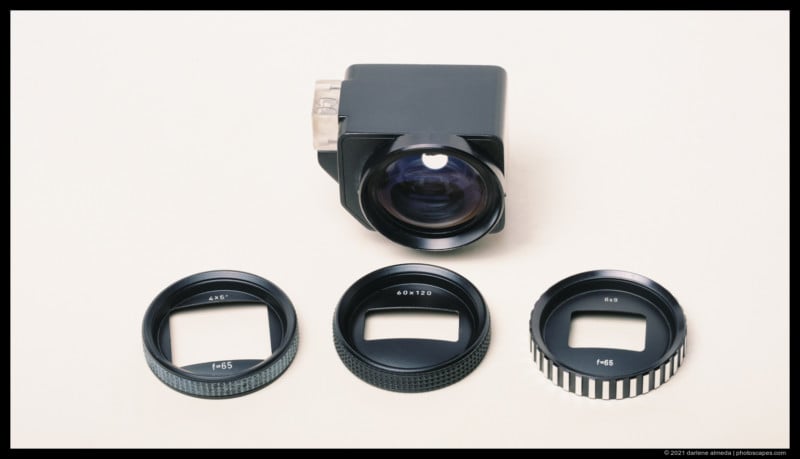
Linhof Master Technika 3000
The Linhof is my favorite camera because of its quality and versatility. When I shoot this camera out in the landscape, I previsualize with the help of the Linhof 4×5″ Viewfinder. I use lenses in the 65, 90, 150 and 210 range and can easily turn the dial of the viewfinder to match the specific lens. I use the ground glass for focusing when shooting 4×5″ film and Live View when shooting digital. This camera is precise enough to shoot with digital from my experience and can use my Cambo and Hasselblad accessories.
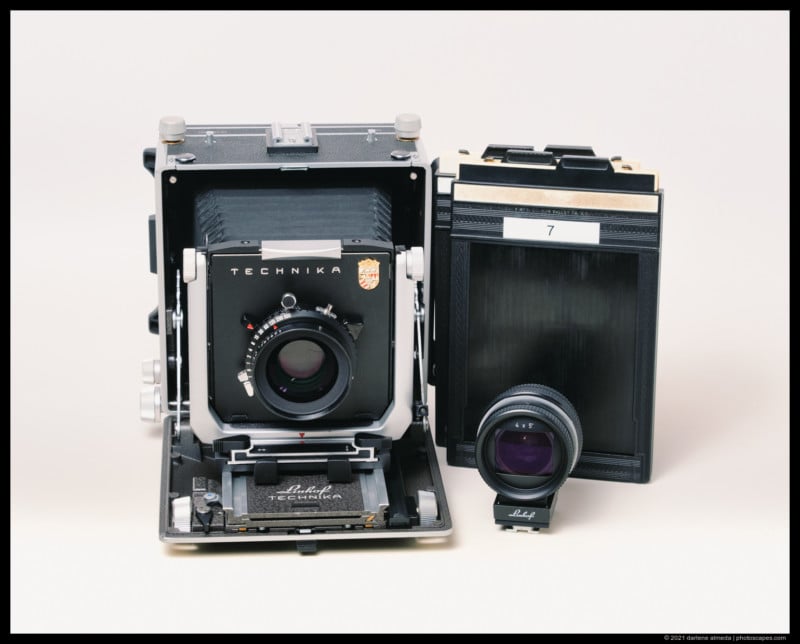
In Closing…
Pre-visualizing is simply knowing what you want to shoot and then making the image. How we get there is an individual approach that most photographers will work on throughout their photographic life. What helps to polish my “eye” is looking at art. I spent a few years studying art history in college only for the slide shows. If you spend time identifying what makes classic art “classic”, you will be educating your eye on “design that works”. The more you do this, the easier pre-visualizing gets.
The gear I use today accounts for a thirty-year career in the visual arts and years of buying and selling to get what I want. I have changed gear periodically, but the gear in this article (or similar) has been in my toolbox for many years. I found switching gear because new stuff is available was not always a good thing for my mental checklist; I like knowing my gear like my right hand. I encourage you to work with what gear you have and to work more on looking at art if you are unhappy with your compositions.
I was told by a longtime Linhof salesman that the 4×5″ and 6×9 viewfinders are the same, the painted lens numbers on the dials are the only difference along with the mask openings. I do not care if a viewfinder is in metric or feet, all I care about is that the view through it matches my lens as close as possible. I find it relaxing to visually explore inside the landscape prior to carrying gear. When I return for image-making, my camera is set up with the correct lens, filter, etc., and I will know ahead of time what technique for capture will be best.
A few photographers have reached out to me and shared their positive experiences using the Mark II Artist’s Viewfinder, an electronic viewfinder for your cell phone. I do have the ALPA version but found upon using it that I prefer to walk around with an optical viewfinder. An electronic viewfinder is an excellent tool for the right photographer, I am just not thrilled with using my cell phone for anything but calling and music syncing because of battery consumption. But if it works for you, it should be used!
When shooting on location, I wear a cloth waist pack that can hold a digital back, film magazine, lenses, and other essentials. It is “my free assistant” and I would never travel without one. At times I need a second set of hands and that is when this pack is indispensable for me. I have both sizes and find their lightweight construction top-notch.
Live View on a digital back was a breakthrough tool for a lot of technical camera shooters, but we quickly learned it eats batteries. I try my best to conserve battery life and rely on Live View for a quick compositional view and focusing only.
My Hasselblad CFi 180/4 lens is one of my favorites for landscape shooting. Here is an image made with it.
I hope this article was informative!
Photo credits: Images and Text ©2021 Darlene Almeda and republished with permission. Camera Work: Fujifilm X-Pro3 + XC 55-230/4.5-6.7
About the author: Darlene Almeda is a commercial photographer and photography teacher of over 30 years. You can find more of her work and writing on her website and blog. This article was also published here.
No comments:
Post a Comment